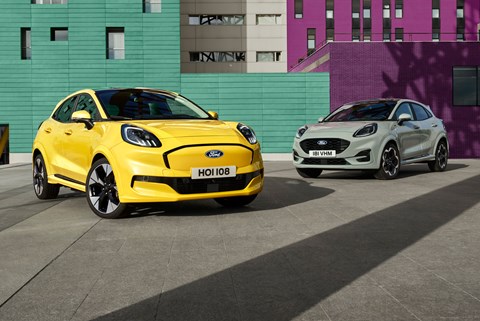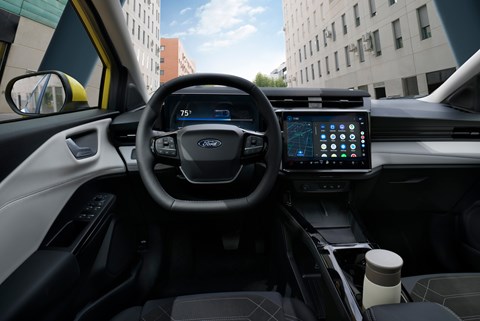► Ford launches its new entry-level EV
► It’s based on its best-selling petrol SUV
► And it doesn’t stray too far from its roots
It’s finally here. After more than a year of teasers and spy shots, the new Ford Puma Gen-E has hit the market. It’s the latest step in Ford’s bold electrification strategy, following hot on the heels of the controversial Capri EV, that’ll see the brand go all-electric by 2030.
Unlike Ford’s most recent electric cars, the Puma EV is completely homegrown. The Capri and the Explorer both use a reworked version of the Volkswagen Group’s MEB architecture, but the electric Puma is built on an updated version of the petrol car’s platform. So, there’s a chance it’ll still drive like a Ford should.
Ford started by junking the Puma’s 1.0-litre petrol engines in favour of a 165bhp electric motor. And, because the motor powers the same wheels and occupies the same amount of space as the petrol engine, there’s no impact on the Puma’s packaging.

It has had an impact on performance, though. The Puma EV can sprint from 0–62mph in eight seconds flat, which is only 0.6 seconds behind the petrol-powered Puma ST.
There’s a chance we’ll get a spicy ST version of the EV, too. We chatted to Murat Güler, lead designer for the Puma EV – and he told us: ‘Again, that’s something I cannot talk about. You know how limited we are there.
‘But yeah, we have an ST on the ICE currently still, so that could be an option one day hopefully. Let’s get this on the road first and get it nice and successful, hopefully, and then we see what other options we have.’ That’s covert marketing speak for ‘it’s happening.’
What about the battery pack?
Ford had to be a little more intelligent about where it mounted the Puma’s battery. Because the B-car platform was never really designed with electrification in mind, Ford’s engineers couldn’t place the battery under the floor (like the Mustang Mach-E, Capri, Explorer and basically every other electric car to hit the market in the last five years).

Instead, they carved out some space under the rear seats and stuck the battery there. As a result, it’s not very big. It only has a usable capacity of 43kWh, which Ford says is enough for a maximum driving range of 234 miles. However, Ford also says this is an EV designed for the town – so it’s confident that limited range won’t be such a massive issue.
There are a couple of benefits to having a small battery, too. Firstly, charge times are fast. Connect the car up to a 100kW DC rapid charger and you’ll be able to thrash the battery from 10–80% capacity in just 23 minutes. A smaller battery means less weight, too. In fact, the Puma EV weighs just 1563kg – and that’s only 247kg more than the standard car.
What else has changed?
The styling for starters. Ford has swapped the petrol car’s open grille for a blanked-off front end to improve the Puma’s aerodynamics. But, so the EV doesn’t look like it’s had its mouth stitched shut in some kind of cruel torture incident, there’s an outline of where the grille used to be.
Mürat Guler, Ford’s lead designer for the Capri and Puma EV, explained the process to me – and it wasn’t as straightforward as you’d think. He said: ‘at one point we almost overcooked it because we removed a lot of the elements. Some of those black graphics in the grille. But then it looked so bland, you know. It had no face. And then we thought – okay, this is too much. We have to go back and introduce some of the graphical elements of the car.’

A happy side effect of the new electric powertrain is that the Puma now has more space inside. Ford has redesigned the EV’s floor to compensate for its lack of an exhaust or gearbox – and that means the rear floor is almost completely flat. That’s liberated some more foot space for those in the back.
The EV’s boot is also a lot bigger thanks to its larger Megabox. It’s so much larger, in fact, that Ford has renamed it the Gigabox. Because there’s now no exhaust to dodge, the EV’s underfloor storage bin spans the width of the boot floor, bumping up maximum boot space to a simply enormous 574 litres. For context, that’s just 26 litres shy of the Skoda Octavia, which is a staggering achievement for a car that’s almost 500mm shorter.

The rest of the cabin is pretty much the same as the facelifted petrol Puma. The 12.0-inch touchscreen, 12.8-inch digital gauge cluster and square steering wheel are all identical. However, the centre console is a little different, as Ford has moved the Puma EV’s gear selector onto the steering column and created a new raised section for some extra storage.